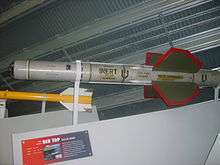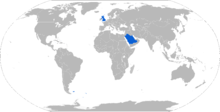Red Top (missile)
| Red Top | |
|---|---|
|
Red Top missile | |
| Type | Air-to-air missile |
| Place of origin | United Kingdom |
| Service history | |
| In service | 1964 - 1988 |
| Used by | United Kingdom, Saudi Arabia, Kuwait |
| Production history | |
| Manufacturer | Hawker Siddeley Dynamics |
| Variants | ? |
| Specifications | |
| Weight | 154 kg |
| Length | 3.32 m |
| Diameter | 0.23 m |
| Warhead | 31 kg (68.3 lb) annular blast fragmentation |
Detonation mechanism | Green Garland infrared proximity; secondary contact fuze |
|
| |
| Engine | Linnet solid fuel motor |
| Wingspan | 0.91 m |
Operational range | 7.5 miles (12 km) |
| Speed | Mach 3.2 |
Guidance system | infrared homing, limited all-aspect |
Steering system | control surfaces |
The Hawker Siddeley (later British Aerospace) Red Top was the third indigenous British air-to-air missile to enter service, following the de Havilland Firestreak and limited-service Fairey Fireflash.
Development
Red Top was originally a rationalized, upgraded version of the earlier Firestreak air-to-air missile. In 1956, de Havilland Propellers started work on the Blue Jay Mark 4 (its development codename) and Firestreak Mk. IV.[1] Such were the changes that it was effectively a new missile. It arranged its components in more logical fashion than the Firestreak (which had its warhead in the tail), with an improved "Violet Banner" seeker, "Green Garland" IR fuze, and a more powerful "Linnet" booster rocket.[1] It also had a larger warhead, at 31 kg (68.3 lb) against 22.7 kg (50 lb).
The Red Top was faster,[2] and had greater range and maneuvrability than the Firestreak, and its more sensitive infrared seeker enabled a wider range of engagement angles. Being more sensitive it could home in on a target that had been warmed by air friction heating.[3] In the aftermath of the 1957 Defence White Paper, Red Top was initially seen to be a stopgap measure only until the Bloodhound Mk. II SAM came into service. This meant that some of the planned improvements to Red Top were never carried out, including all-aspect capability (as seen on the later AIM-9L/M Sidewinder).[4] Red Top was only "capable of all aspect homing against super-sonic targets."[2] "Unlike modern [1990s] missiles, Red Top and Firestreak could only be fired outside cloud, and in winter, skies were rarely clear over the UK."[5]
The Red Top entered service in 1964, arming the English Electric Lightning and de Havilland Sea Vixen. It remained in limited service until the final retirement of the Lightning in 1988.[6] Unusually, the missile that the Red Top was intended to replace – Firestreak – also remained in limited service on the Lightning until 1988.
A variant called Blue Dolphin or Blue Jay Mk. V, was proposed, using semi-active radar homing for capability similar to the AIM-7 Sparrow, but this was cancelled in 1958.[4]


Former operators

See also
References
- 1 2 Gibson 2007, p. 40
- 1 2 Boyne, Walter J, Air Warfare: an International Encyclopedia, Volume 1, pub ABC-CLIO Inc, 2002, ISBN 1-57607-345-9 p267.
- ↑ The English Electric (BAC) Lightning
- 1 2 Gibson 2007, p. 41
- ↑ Black, Ian, The Last of the Lightnings, pub PSL, 1996, ISBN 1-85260-541-3, p141.
- ↑ Gibson 2007, p. 41, 42
Bibliography
- Gibson, Chris; Buttler, Tony (2007). British Secret Projects: Hypersonics, Ramjets and Missiles. Midland Publishing. pp. 47–53. ISBN 978-1-85780-258-0.
